Best Practices in Vocabulary Instruction: A Sociology Education Plan
VerifiedAdded on 2023/04/08
|8
|1368
|61
Essay
AI Summary
This essay delves into effective vocabulary instruction strategies for sociology students, drawing on insights from experts like Robert Marzano, Janet Allen, Anita Archer, Kylene Beers, and Laura Robb. It outlines a detailed plan for teaching new vocabulary, emphasizing the importance of repetition and varied activities such as word maps, music, root analysis, and contextual clues. The plan includes engaging activities like emoji prompts, Lego bricks, and Pictionary to review and connect terms, as well as strategies for student self-reflection, such as triangle reflections and reflective journals. The essay concludes by addressing methods for monitoring student progress, including curriculum-based monitoring and frequent evaluations. This student-contributed assignment is available on Desklib, a platform offering a wealth of study resources and AI-powered tools for students.
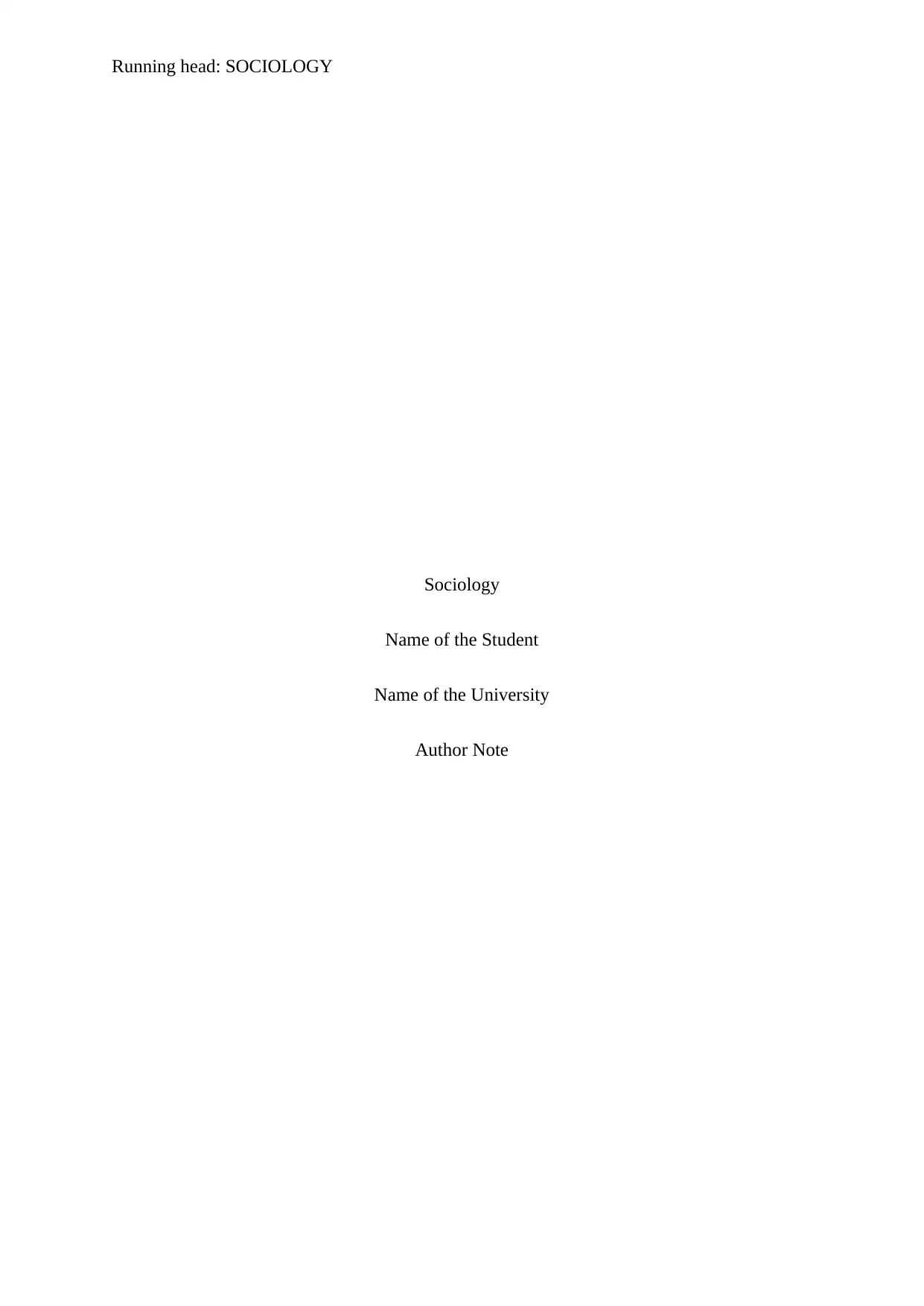
Running head: SOCIOLOGY
Sociology
Name of the Student
Name of the University
Author Note
Sociology
Name of the Student
Name of the University
Author Note
Paraphrase This Document
Need a fresh take? Get an instant paraphrase of this document with our AI Paraphraser
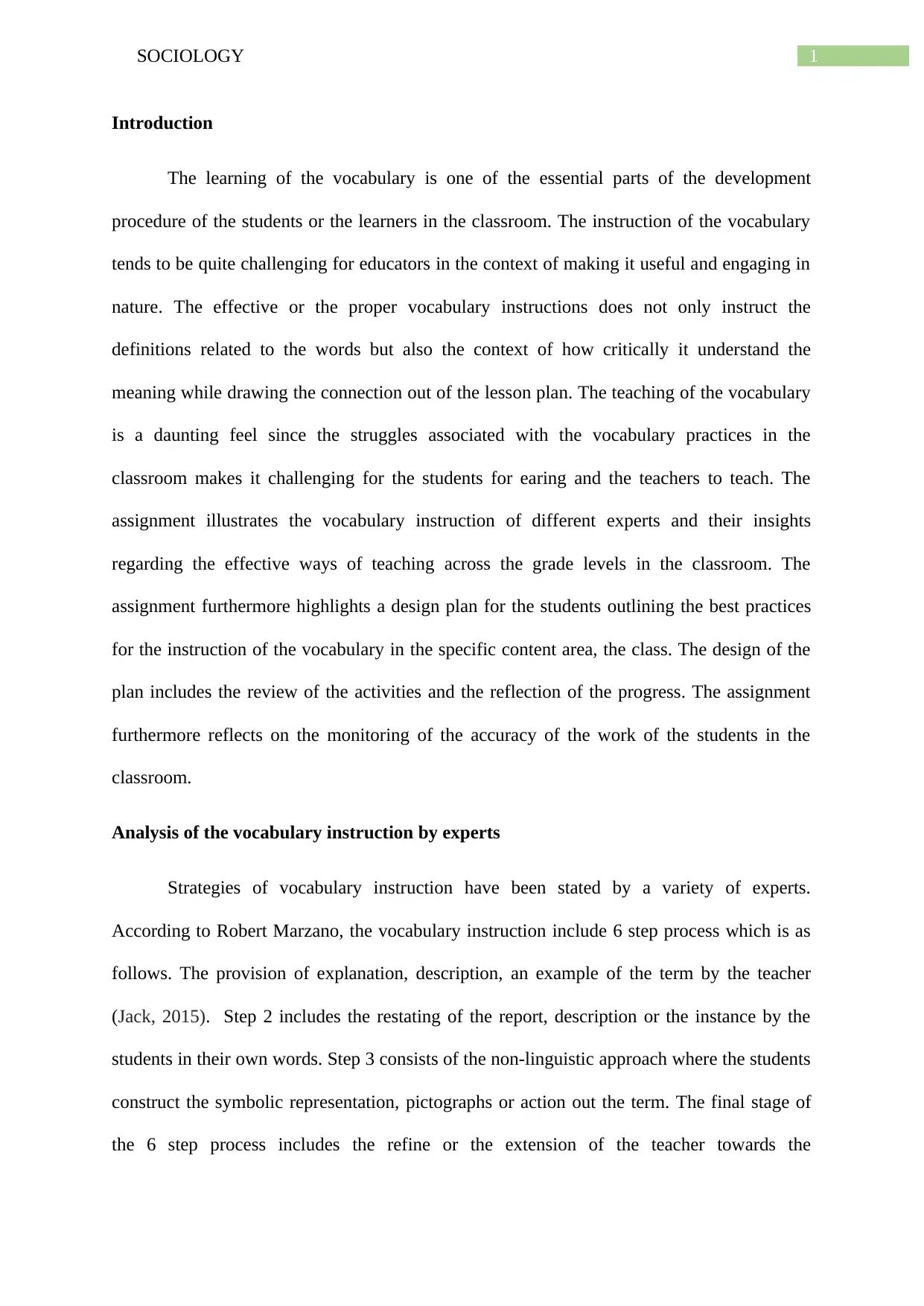
1SOCIOLOGY
Introduction
The learning of the vocabulary is one of the essential parts of the development
procedure of the students or the learners in the classroom. The instruction of the vocabulary
tends to be quite challenging for educators in the context of making it useful and engaging in
nature. The effective or the proper vocabulary instructions does not only instruct the
definitions related to the words but also the context of how critically it understand the
meaning while drawing the connection out of the lesson plan. The teaching of the vocabulary
is a daunting feel since the struggles associated with the vocabulary practices in the
classroom makes it challenging for the students for earing and the teachers to teach. The
assignment illustrates the vocabulary instruction of different experts and their insights
regarding the effective ways of teaching across the grade levels in the classroom. The
assignment furthermore highlights a design plan for the students outlining the best practices
for the instruction of the vocabulary in the specific content area, the class. The design of the
plan includes the review of the activities and the reflection of the progress. The assignment
furthermore reflects on the monitoring of the accuracy of the work of the students in the
classroom.
Analysis of the vocabulary instruction by experts
Strategies of vocabulary instruction have been stated by a variety of experts.
According to Robert Marzano, the vocabulary instruction include 6 step process which is as
follows. The provision of explanation, description, an example of the term by the teacher
(Jack, 2015). Step 2 includes the restating of the report, description or the instance by the
students in their own words. Step 3 consists of the non-linguistic approach where the students
construct the symbolic representation, pictographs or action out the term. The final stage of
the 6 step process includes the refine or the extension of the teacher towards the
Introduction
The learning of the vocabulary is one of the essential parts of the development
procedure of the students or the learners in the classroom. The instruction of the vocabulary
tends to be quite challenging for educators in the context of making it useful and engaging in
nature. The effective or the proper vocabulary instructions does not only instruct the
definitions related to the words but also the context of how critically it understand the
meaning while drawing the connection out of the lesson plan. The teaching of the vocabulary
is a daunting feel since the struggles associated with the vocabulary practices in the
classroom makes it challenging for the students for earing and the teachers to teach. The
assignment illustrates the vocabulary instruction of different experts and their insights
regarding the effective ways of teaching across the grade levels in the classroom. The
assignment furthermore highlights a design plan for the students outlining the best practices
for the instruction of the vocabulary in the specific content area, the class. The design of the
plan includes the review of the activities and the reflection of the progress. The assignment
furthermore reflects on the monitoring of the accuracy of the work of the students in the
classroom.
Analysis of the vocabulary instruction by experts
Strategies of vocabulary instruction have been stated by a variety of experts.
According to Robert Marzano, the vocabulary instruction include 6 step process which is as
follows. The provision of explanation, description, an example of the term by the teacher
(Jack, 2015). Step 2 includes the restating of the report, description or the instance by the
students in their own words. Step 3 consists of the non-linguistic approach where the students
construct the symbolic representation, pictographs or action out the term. The final stage of
the 6 step process includes the refine or the extension of the teacher towards the
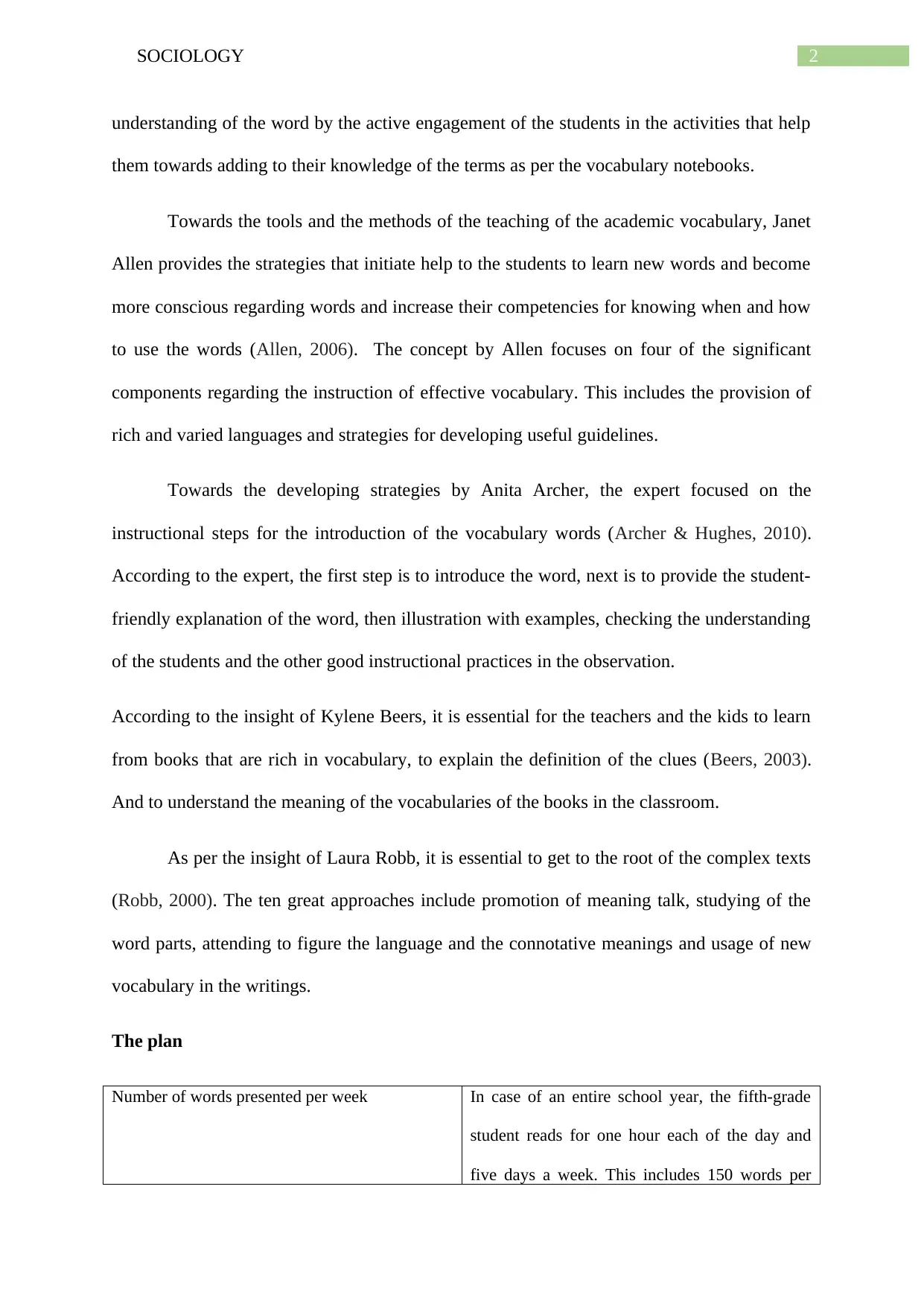
2SOCIOLOGY
understanding of the word by the active engagement of the students in the activities that help
them towards adding to their knowledge of the terms as per the vocabulary notebooks.
Towards the tools and the methods of the teaching of the academic vocabulary, Janet
Allen provides the strategies that initiate help to the students to learn new words and become
more conscious regarding words and increase their competencies for knowing when and how
to use the words (Allen, 2006). The concept by Allen focuses on four of the significant
components regarding the instruction of effective vocabulary. This includes the provision of
rich and varied languages and strategies for developing useful guidelines.
Towards the developing strategies by Anita Archer, the expert focused on the
instructional steps for the introduction of the vocabulary words (Archer & Hughes, 2010).
According to the expert, the first step is to introduce the word, next is to provide the student-
friendly explanation of the word, then illustration with examples, checking the understanding
of the students and the other good instructional practices in the observation.
According to the insight of Kylene Beers, it is essential for the teachers and the kids to learn
from books that are rich in vocabulary, to explain the definition of the clues (Beers, 2003).
And to understand the meaning of the vocabularies of the books in the classroom.
As per the insight of Laura Robb, it is essential to get to the root of the complex texts
(Robb, 2000). The ten great approaches include promotion of meaning talk, studying of the
word parts, attending to figure the language and the connotative meanings and usage of new
vocabulary in the writings.
The plan
Number of words presented per week In case of an entire school year, the fifth-grade
student reads for one hour each of the day and
five days a week. This includes 150 words per
understanding of the word by the active engagement of the students in the activities that help
them towards adding to their knowledge of the terms as per the vocabulary notebooks.
Towards the tools and the methods of the teaching of the academic vocabulary, Janet
Allen provides the strategies that initiate help to the students to learn new words and become
more conscious regarding words and increase their competencies for knowing when and how
to use the words (Allen, 2006). The concept by Allen focuses on four of the significant
components regarding the instruction of effective vocabulary. This includes the provision of
rich and varied languages and strategies for developing useful guidelines.
Towards the developing strategies by Anita Archer, the expert focused on the
instructional steps for the introduction of the vocabulary words (Archer & Hughes, 2010).
According to the expert, the first step is to introduce the word, next is to provide the student-
friendly explanation of the word, then illustration with examples, checking the understanding
of the students and the other good instructional practices in the observation.
According to the insight of Kylene Beers, it is essential for the teachers and the kids to learn
from books that are rich in vocabulary, to explain the definition of the clues (Beers, 2003).
And to understand the meaning of the vocabularies of the books in the classroom.
As per the insight of Laura Robb, it is essential to get to the root of the complex texts
(Robb, 2000). The ten great approaches include promotion of meaning talk, studying of the
word parts, attending to figure the language and the connotative meanings and usage of new
vocabulary in the writings.
The plan
Number of words presented per week In case of an entire school year, the fifth-grade
student reads for one hour each of the day and
five days a week. This includes 150 words per
⊘ This is a preview!⊘
Do you want full access?
Subscribe today to unlock all pages.

Trusted by 1+ million students worldwide
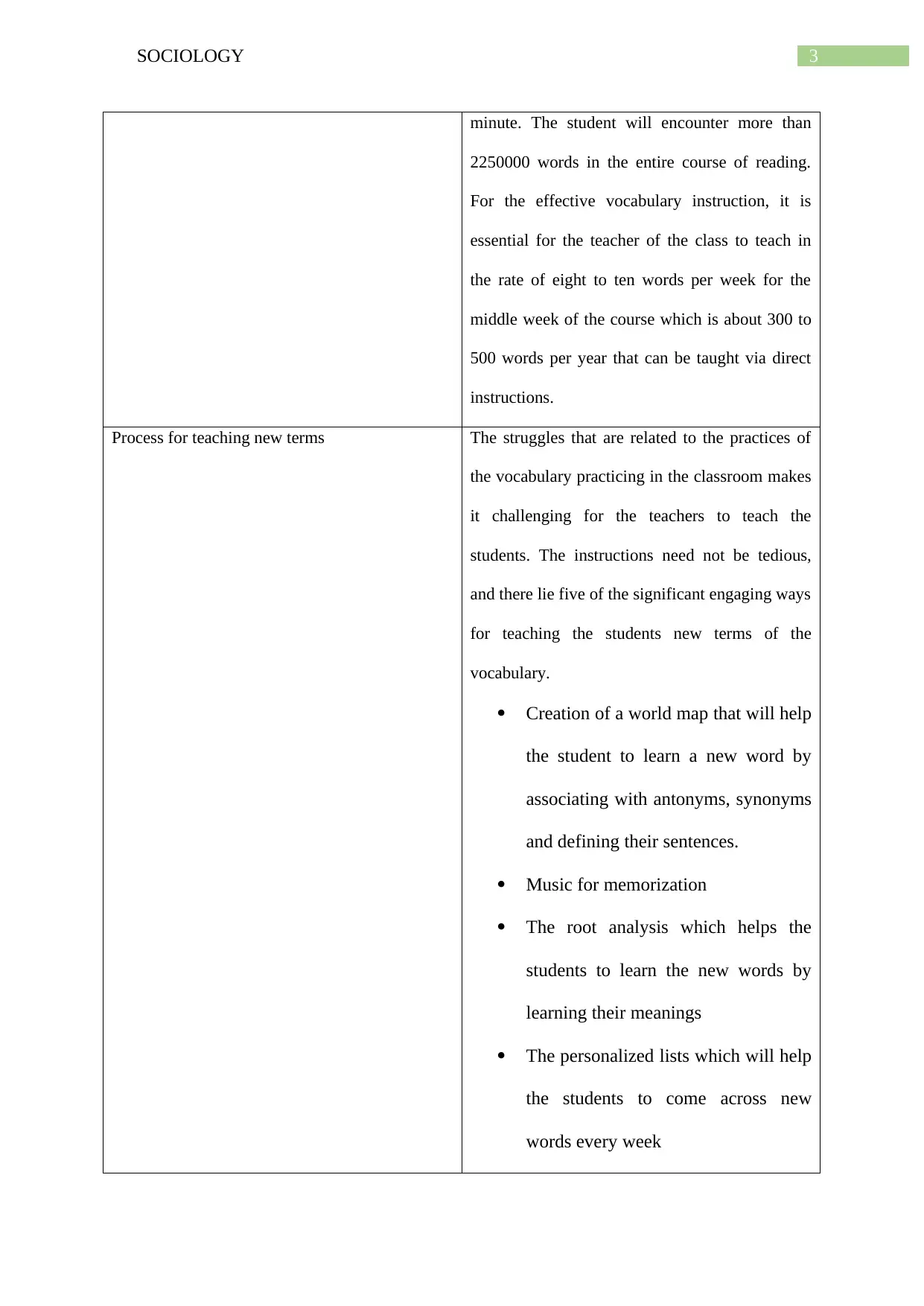
3SOCIOLOGY
minute. The student will encounter more than
2250000 words in the entire course of reading.
For the effective vocabulary instruction, it is
essential for the teacher of the class to teach in
the rate of eight to ten words per week for the
middle week of the course which is about 300 to
500 words per year that can be taught via direct
instructions.
Process for teaching new terms The struggles that are related to the practices of
the vocabulary practicing in the classroom makes
it challenging for the teachers to teach the
students. The instructions need not be tedious,
and there lie five of the significant engaging ways
for teaching the students new terms of the
vocabulary.
Creation of a world map that will help
the student to learn a new word by
associating with antonyms, synonyms
and defining their sentences.
Music for memorization
The root analysis which helps the
students to learn the new words by
learning their meanings
The personalized lists which will help
the students to come across new
words every week
minute. The student will encounter more than
2250000 words in the entire course of reading.
For the effective vocabulary instruction, it is
essential for the teacher of the class to teach in
the rate of eight to ten words per week for the
middle week of the course which is about 300 to
500 words per year that can be taught via direct
instructions.
Process for teaching new terms The struggles that are related to the practices of
the vocabulary practicing in the classroom makes
it challenging for the teachers to teach the
students. The instructions need not be tedious,
and there lie five of the significant engaging ways
for teaching the students new terms of the
vocabulary.
Creation of a world map that will help
the student to learn a new word by
associating with antonyms, synonyms
and defining their sentences.
Music for memorization
The root analysis which helps the
students to learn the new words by
learning their meanings
The personalized lists which will help
the students to come across new
words every week
Paraphrase This Document
Need a fresh take? Get an instant paraphrase of this document with our AI Paraphraser
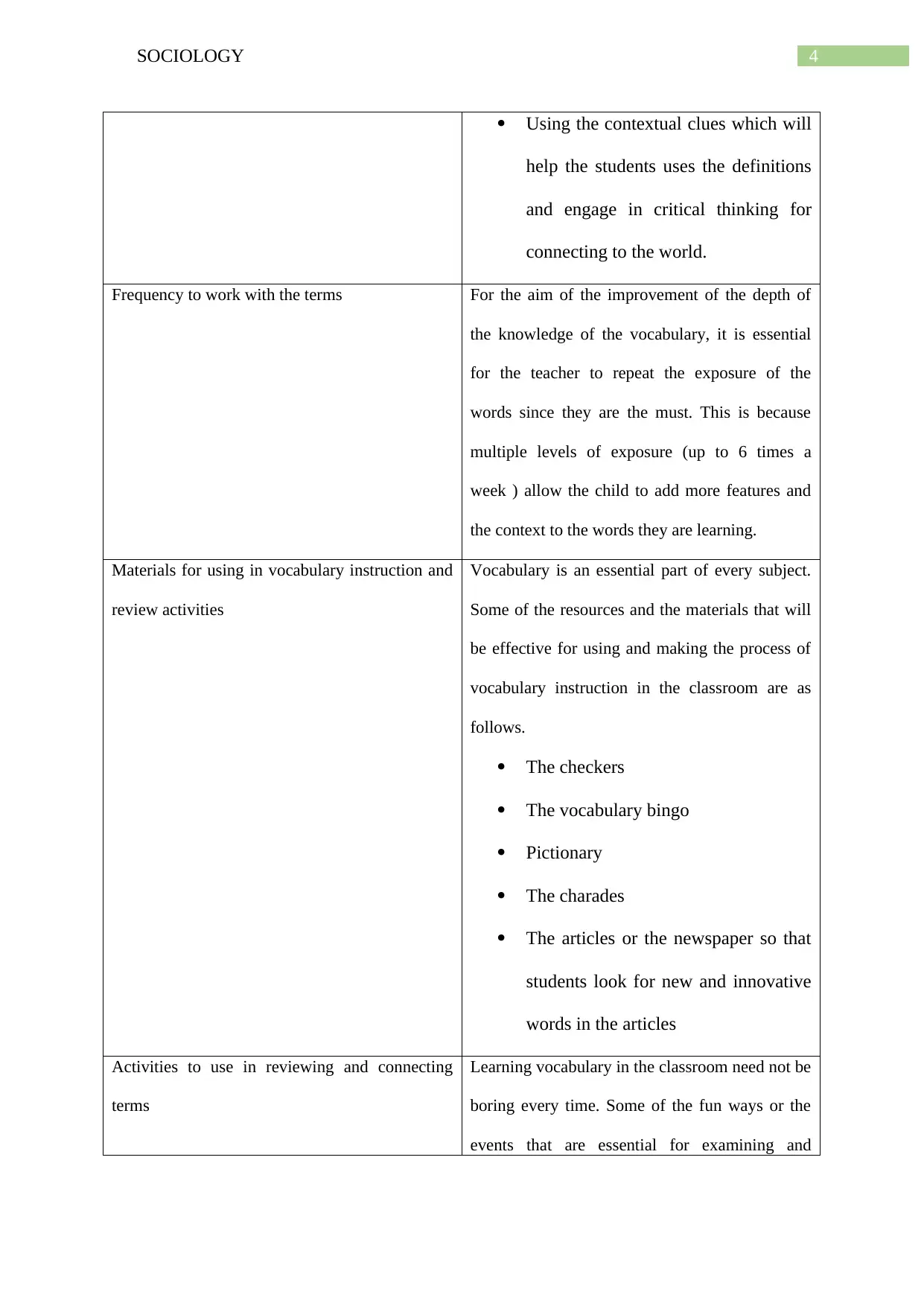
4SOCIOLOGY
Using the contextual clues which will
help the students uses the definitions
and engage in critical thinking for
connecting to the world.
Frequency to work with the terms For the aim of the improvement of the depth of
the knowledge of the vocabulary, it is essential
for the teacher to repeat the exposure of the
words since they are the must. This is because
multiple levels of exposure (up to 6 times a
week ) allow the child to add more features and
the context to the words they are learning.
Materials for using in vocabulary instruction and
review activities
Vocabulary is an essential part of every subject.
Some of the resources and the materials that will
be effective for using and making the process of
vocabulary instruction in the classroom are as
follows.
The checkers
The vocabulary bingo
Pictionary
The charades
The articles or the newspaper so that
students look for new and innovative
words in the articles
Activities to use in reviewing and connecting
terms
Learning vocabulary in the classroom need not be
boring every time. Some of the fun ways or the
events that are essential for examining and
Using the contextual clues which will
help the students uses the definitions
and engage in critical thinking for
connecting to the world.
Frequency to work with the terms For the aim of the improvement of the depth of
the knowledge of the vocabulary, it is essential
for the teacher to repeat the exposure of the
words since they are the must. This is because
multiple levels of exposure (up to 6 times a
week ) allow the child to add more features and
the context to the words they are learning.
Materials for using in vocabulary instruction and
review activities
Vocabulary is an essential part of every subject.
Some of the resources and the materials that will
be effective for using and making the process of
vocabulary instruction in the classroom are as
follows.
The checkers
The vocabulary bingo
Pictionary
The charades
The articles or the newspaper so that
students look for new and innovative
words in the articles
Activities to use in reviewing and connecting
terms
Learning vocabulary in the classroom need not be
boring every time. Some of the fun ways or the
events that are essential for examining and
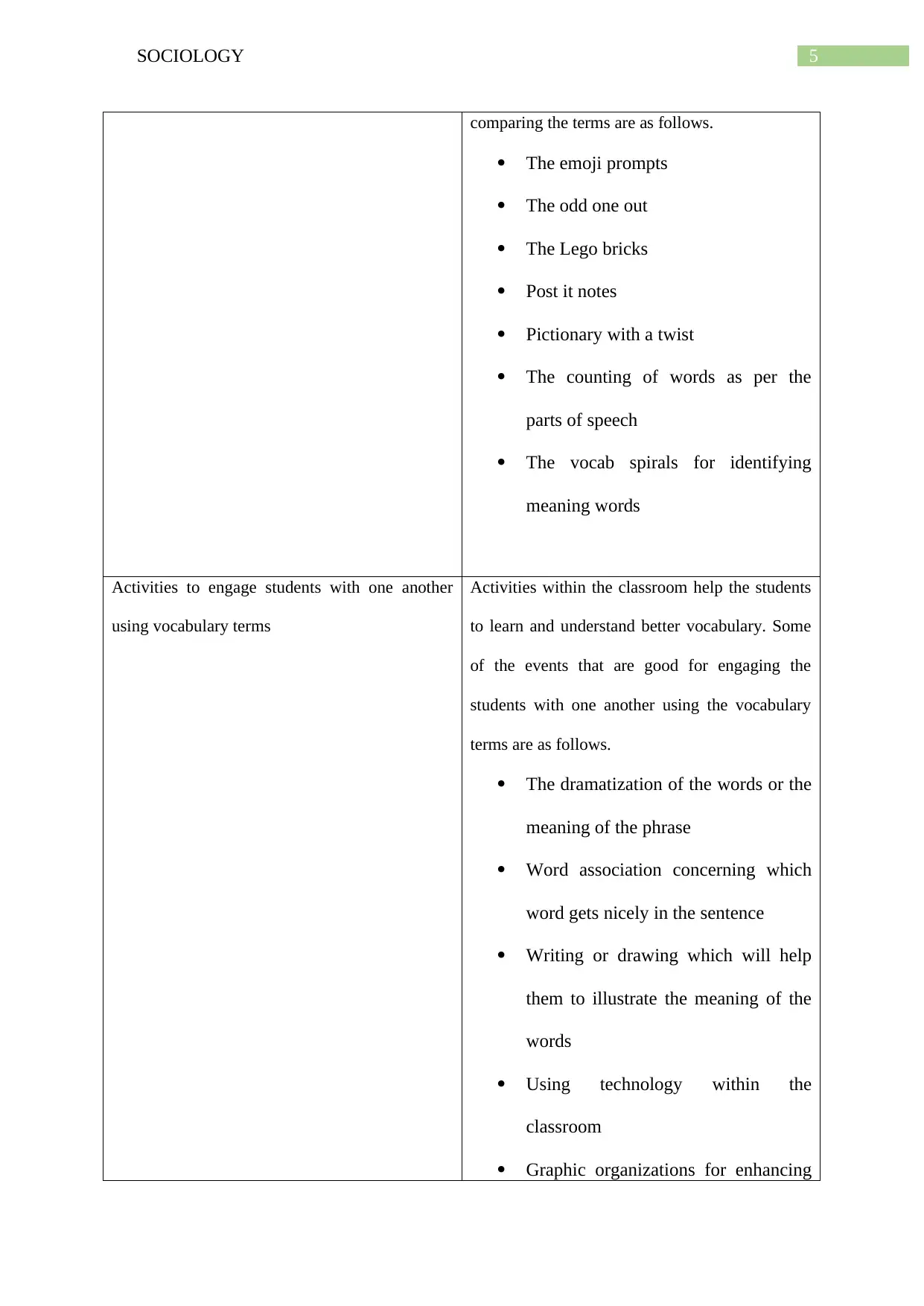
5SOCIOLOGY
comparing the terms are as follows.
The emoji prompts
The odd one out
The Lego bricks
Post it notes
Pictionary with a twist
The counting of words as per the
parts of speech
The vocab spirals for identifying
meaning words
Activities to engage students with one another
using vocabulary terms
Activities within the classroom help the students
to learn and understand better vocabulary. Some
of the events that are good for engaging the
students with one another using the vocabulary
terms are as follows.
The dramatization of the words or the
meaning of the phrase
Word association concerning which
word gets nicely in the sentence
Writing or drawing which will help
them to illustrate the meaning of the
words
Using technology within the
classroom
Graphic organizations for enhancing
comparing the terms are as follows.
The emoji prompts
The odd one out
The Lego bricks
Post it notes
Pictionary with a twist
The counting of words as per the
parts of speech
The vocab spirals for identifying
meaning words
Activities to engage students with one another
using vocabulary terms
Activities within the classroom help the students
to learn and understand better vocabulary. Some
of the events that are good for engaging the
students with one another using the vocabulary
terms are as follows.
The dramatization of the words or the
meaning of the phrase
Word association concerning which
word gets nicely in the sentence
Writing or drawing which will help
them to illustrate the meaning of the
words
Using technology within the
classroom
Graphic organizations for enhancing
⊘ This is a preview!⊘
Do you want full access?
Subscribe today to unlock all pages.

Trusted by 1+ million students worldwide
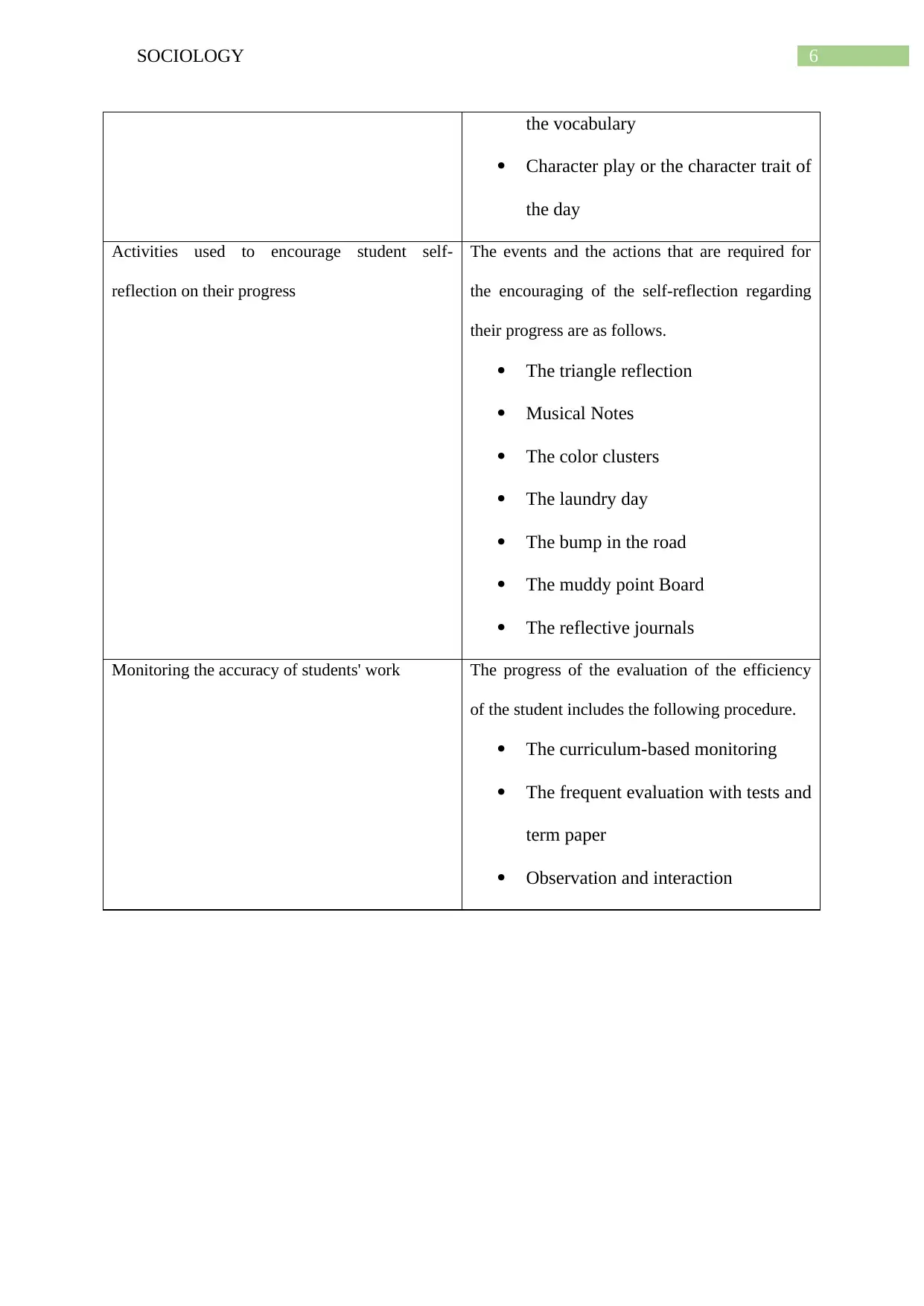
6SOCIOLOGY
the vocabulary
Character play or the character trait of
the day
Activities used to encourage student self-
reflection on their progress
The events and the actions that are required for
the encouraging of the self-reflection regarding
their progress are as follows.
The triangle reflection
Musical Notes
The color clusters
The laundry day
The bump in the road
The muddy point Board
The reflective journals
Monitoring the accuracy of students' work The progress of the evaluation of the efficiency
of the student includes the following procedure.
The curriculum-based monitoring
The frequent evaluation with tests and
term paper
Observation and interaction
the vocabulary
Character play or the character trait of
the day
Activities used to encourage student self-
reflection on their progress
The events and the actions that are required for
the encouraging of the self-reflection regarding
their progress are as follows.
The triangle reflection
Musical Notes
The color clusters
The laundry day
The bump in the road
The muddy point Board
The reflective journals
Monitoring the accuracy of students' work The progress of the evaluation of the efficiency
of the student includes the following procedure.
The curriculum-based monitoring
The frequent evaluation with tests and
term paper
Observation and interaction
Paraphrase This Document
Need a fresh take? Get an instant paraphrase of this document with our AI Paraphraser
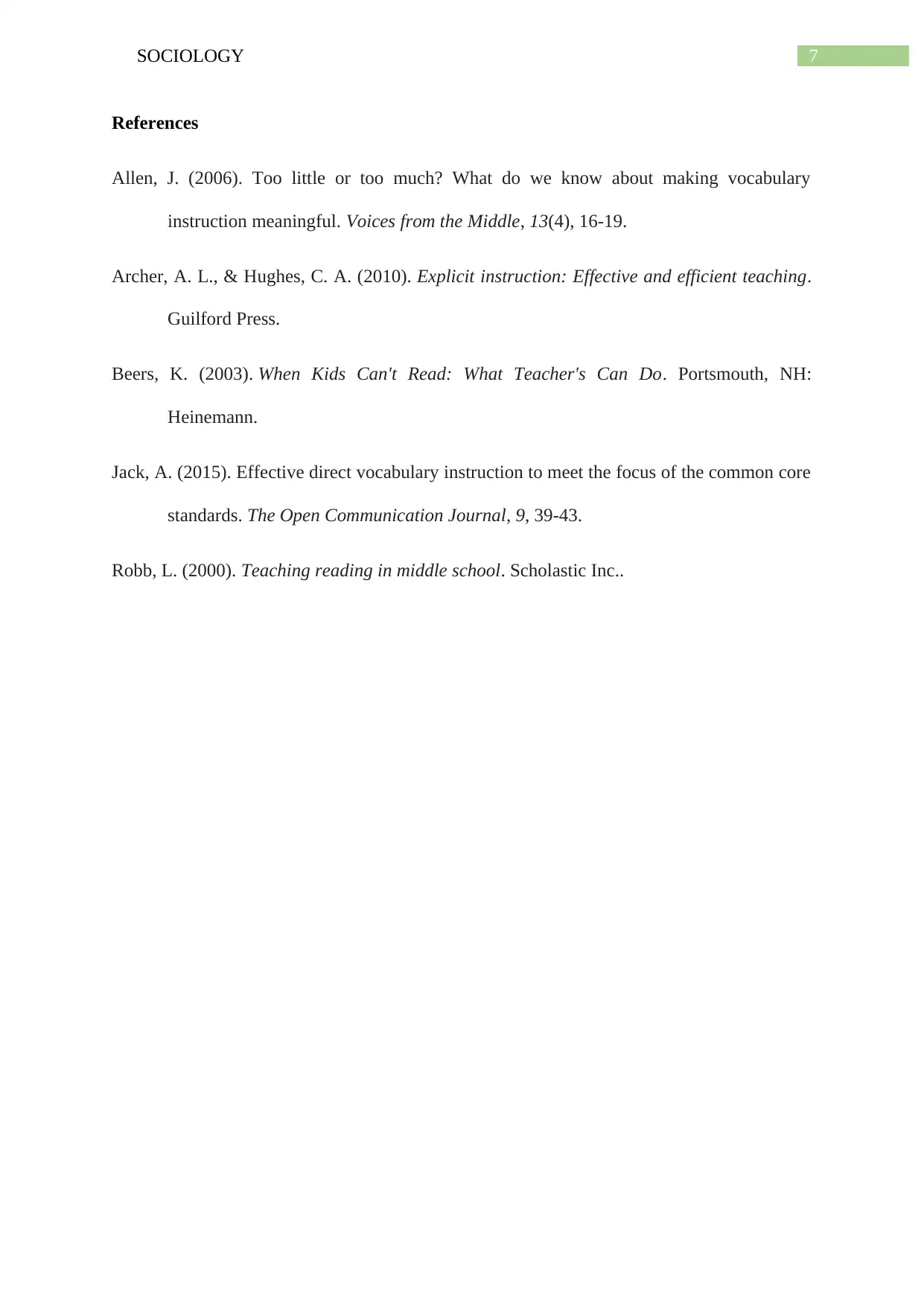
7SOCIOLOGY
References
Allen, J. (2006). Too little or too much? What do we know about making vocabulary
instruction meaningful. Voices from the Middle, 13(4), 16-19.
Archer, A. L., & Hughes, C. A. (2010). Explicit instruction: Effective and efficient teaching.
Guilford Press.
Beers, K. (2003). When Kids Can't Read: What Teacher's Can Do. Portsmouth, NH:
Heinemann.
Jack, A. (2015). Effective direct vocabulary instruction to meet the focus of the common core
standards. The Open Communication Journal, 9, 39-43.
Robb, L. (2000). Teaching reading in middle school. Scholastic Inc..
References
Allen, J. (2006). Too little or too much? What do we know about making vocabulary
instruction meaningful. Voices from the Middle, 13(4), 16-19.
Archer, A. L., & Hughes, C. A. (2010). Explicit instruction: Effective and efficient teaching.
Guilford Press.
Beers, K. (2003). When Kids Can't Read: What Teacher's Can Do. Portsmouth, NH:
Heinemann.
Jack, A. (2015). Effective direct vocabulary instruction to meet the focus of the common core
standards. The Open Communication Journal, 9, 39-43.
Robb, L. (2000). Teaching reading in middle school. Scholastic Inc..
1 out of 8
Related Documents
Your All-in-One AI-Powered Toolkit for Academic Success.
+13062052269
info@desklib.com
Available 24*7 on WhatsApp / Email
![[object Object]](/_next/static/media/star-bottom.7253800d.svg)
Unlock your academic potential
Copyright © 2020–2025 A2Z Services. All Rights Reserved. Developed and managed by ZUCOL.





